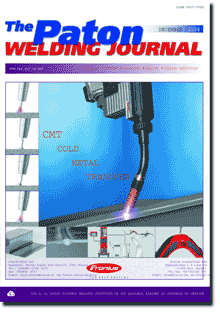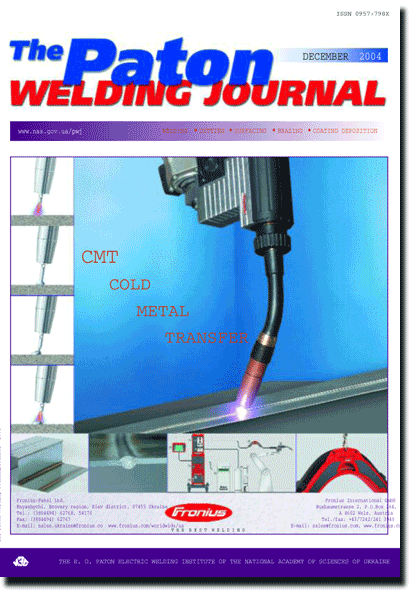

| SCIENTIFIC AND TECHNICAL | |
| Yushchenko K.A., Savchenko V.S. andStarushchenko T.M. Role of segregation of oxygen in welding of Invar type alloys | 2 |
| It has been found that cracks in welding of Fe?36 % Ni alloy are formed primarily at temperatures that are much lower than solidus temperature, i.e. within the ductility-dip temperature range. Conditions causing enrichment of weld metal with oxygen are formed in a joint during the welding process. Subsequent cooling leads to enrichment of high-angle grain boundaries with oxygen due to thermal-deformation processes occurring in metal, which leads to decrease in ductility and embrittlement. Investigations by the Varestraint test method have shown existence of quantitative relationship between the effect of oxygen and ductility dip in the weld metal. | |
| Sidorets V.N. and Zhernosekov A.M. Numerical simulation of the system of power source?consumable-electrode arc | 9 |
| A mathematical description of the power source?consumable-electrode arc system is proposed. Conditions of static existence of the system are studied, allowing for the thermophysical characteristics of the parameters and variation of electrode stick-out. | |
| Ciric R., Cantrak S. and Raic K. Analysis of the mechanism of joining and formation of viscous layer in friction stir welding | 16 |
| Phenomena developing in the process of continuous friction stir welding of high-speed steel R6M5 to carbon steel 60 are considered. Mathematical expression to calculate radial displacements of metal directly up to the friction surface has been proposed and experimentally verified. Structure, phase composition and chemistry of a viscous layer, friction plane and neighbouring zones have been examined. | |
| Pismenny A.S., Novikova D.P., Prokofiev A.S. and Polukhin V.V. Properties of weld metal at induction braze-welding of steel 20 | 26 |
| The paper gives the results of studying the microhardness of the metal of the weld and HAZ produced by the method of induction-press welding (braze-welding) with application of activating materials. It is established that the weld metal is an alloy based on the parent metal of the parts being joined. It is determined that deformation coefficient required for performance of sound welds is within kd = 0.025--0.050. It is shown that during performance of braze-welding with contact trajectory along a closed cylindrical surface, up to 25 % of the joint zone is not visualized and the billets are joined over the base metal. | |
| INDUSTRIAL | |
| Saraev Yu.N., Bezborodov V.P., Poletika I.M.,Tyutev A.V., Nikonova I.V., Kirilova N.V. and Sevastianov S.P. Improvement of the structure and properties of welded joints in large-diameter oil and gas pipes | 33 |
| Effect of a pulsed welding process on the structure and mechanical properties of welded joints in large-diameter (1420mm) pipes of manganese low-alloy steels, intended for manufacture of oil and gas pipelines, has been studied. It is shown that the pulse welding conditions make it possible to improve the homogeneity of the structure and reduce the grain size of metal of the weld and HAZ zones. Structural changes at a positive temperature (20 oC) lead to increase of 8--27 %, and at a negative temperature (-60 oC) to increase of 15--24 % in ductility and impact toughness of the welded joint zones. | |
| Karasyov M.V., Vyshemirsky E.M., Bespalov V.I., Rabotinsky D.N., Zakharov I.M., Belyaev A.E., Pavlenko G.V. and Solyanik V.V. Characteristics of modern units for mechanised GMA welding | 36 |
| Described are modern types and characteristics of application of new mechanised welding technologies using solid (small diameter) and flux-cored wires. It is shown that allowance for the dynamic properties of welding sources is important for analysis and comparison of mechanised welding units. | |
| Postolaty N.I. Approximate calculation of choke inductance in DC welding circuit | 40 |
| A procedure is described for determination of the required inductance of DC welding circuit and design of welding circuit choke by the admissible rate of current increment. | |
| Zhadkevich A.M. Sources of flame heating for brazing | 44 |
| Retrospective description of development of the equipment and technique of heating during brazing with application of hydrocarbon and hydrogen fuel is given. The technological features and capabilities of flame of different composition in acetylene, hydrogen-oxygen and atomic-hydrogen brazing are analyzed. The role of a number of specialists and organizations in the history of gas and gas-electric brazing is demonstrated. | |
| BRIEF INFORMATION | |
| Kalianov V.N. and Petrenko A.N. Wear resistance of deposited metal with increased share of titanium carbides | 53 |
| The paper gives the results of laboratory studies of wear resistance and technological strength of three types of deposited metal (boron?titanium, austenite-martensite and martensite-austenite). It is shown that steels with a high content of metastable austenite, strengthened by dispersed precipitation of titanium carbides, have the best complex of properties. | |
| Index of articles for TPWJ'2004, Nos. 1--12 | 55 |
| List of authors | 63 |
(You are viewing the simplified file contents)
The cost of subscription/purchase order journals or individual articles
| Journal/Currency | Annual Set | 1 issue printed |
1 issue |
one article |
| TPWJ/USD | 384 $ | 32 $ | 26 $ | 13 $ |
| TPWJ/EUR | 348 € | 29 € | 24 € | 12 € |
| TPWJ/UAH | 7200 UAH | 600 UAH | 600 UAH | 280 UAH |
| AS/UAH | 1800 UAH | 300 UAH | 300 UAH | 150 UAH |
| AS/USD | 192 $ | 32 $ | 26 $ | 13 $ |
| AS/EUR | 180 € | 30 € | 25 € | 12 € |
| SEM/UAH | 1200 UAH | 300 UAH | 300 UAH | 150 UAH |
| SEM/USD | 128 $ | 32 $ | 26 $ | 13 $ |
| SEM/EUR | 120 € | 30 € | 25 € | 12 € |
| TDNK/UAH | 1200 UAH | 300 UAH | 300 UAH | 150 UAH |
| TDNK/USD | 128 $ | 32 $ | 26 $ | 13 $ |
| TDNK/EUR | 120 € | 30 € | 25 € | 15 € |
AS = «Automatic Welding» - 6 issues per year;
TPWJ = «PATON WELDING JOURNAL» - 12 issues per year;
SEM = «Electrometallurgy Today» - 4 issues per year;
TDNK = «Technical Diagnostics and Non-Destructive Testing» - 4 issues per year.


